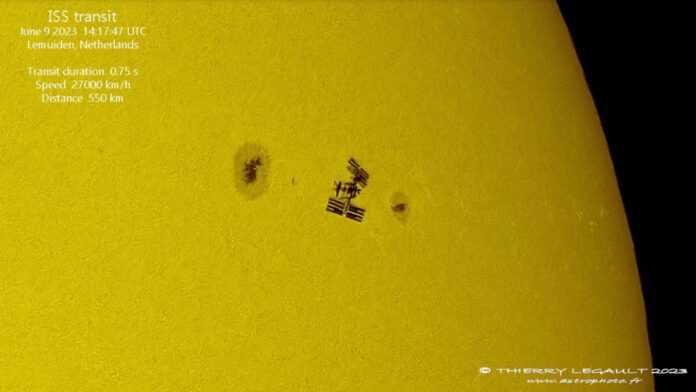Capturing footage of the International Space Station (ISS) hurtling through space at approximately 17,500 mph (28,000 km/h) is no mean feat, yet French astrophotographer Thierry Legault has pulled it off yet again.
In his latest stunning footage, captured on Friday (June 9), Legault imaged the ISS whizzing past three sunspot groups, the largest of them big enough to swallow Earth whole. The entire solar transit lasted just 0.75 seconds.
In addition, Legault captured these shots while two NASA astronauts, Stephen Bowen and Warren “Woody” Hoburg, were carrying out a spacewalk to install a new solar array outside the station.
Related: How to observe the sun safely (and what to look for)
“Oops, I did it again…better!” Legault wrote in a Facebook post, having previously captured the ISS transitting the sun and a giant sunspot on June 6.
Legault drove six hours from his home to go to the Netherlands, where he watched the transit happen just one hour after the spacewalk began.
“This time, the ISS passed in front of 3 sunspots groups in a split second!” Legault wrote.
The ISS orbits Earth every 90 minutes, traveling about the distance from Earth to the moon and back again in just one day.
Though the two targets may look close to each other in Legault’s footage, unlike Icarus, the ISS stays a safe distance from the sun. The ISS orbits approximately 250 miles (402 kilometers) above Earth, but the sun is on average almost 300,000 times farther away from us, at 93 million miles (150 million km).
The secret to capturing such an iconic moment? Precision planning and clear skies!
Equipment used:
CFF200 apo refractor, Baader Herschel wedge, Olympus OM-1, Emmanuel Rietsch’s GPS trigger
“Using real-time images of the sun, I estimated the position of the main sunspot groups towards vertical and horizontal directions (which depends on time and location),” Legault told Space.com in an email.
“I compared it to the trajectory planned by www.transit-finder.com, and I tried to place myself on the corresponding transit line (which was not the center of the transit visibility path),” Legault continued.
According to Legault, all the individual images are single shots at 1/32000s. He doesn’t capture ISS transits with stackings or assemblies.
If you fancy trying to capture images of the orbiting outpost, our how to photograph the ISS guide may help, and to aid your planning efforts, check out our how to see and track the ISS guide.
Our best cameras for astrophotography and best lenses for astrophotography can also help you prepare to capture your next skywatching sight.

